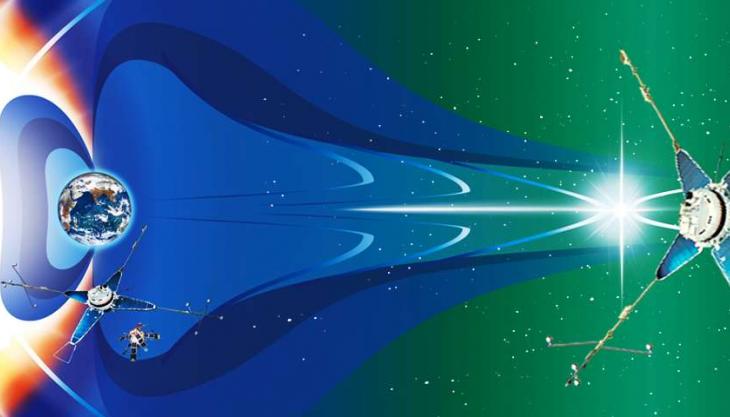Space Plasma Physics

Head of the department
corresponding member of the Russian Academy of Sciences
Dr.Sc. Anatoly A. PETRUKOVICH
Labs
- Theory of Plasma Processes in Space. Head: Dr.Sc. David R. SHKLYAR
- Acceleration Processes in Space Plasma and Space Weather. Head: corresponding member of the Russian Academy of Sciences Dr.Sc. Anatoly A. PETRUKOVICH
- Arctic Heliophysical Center
- Planetary and Interplanetary Plasma
- Electromagnetic Radiation. Head: Dr.Sc. Prof. Stanislav I. KLIMOV
- Solar Wind. Head: Dr.Sc.Yuri I. YERMOLAEV
- Magnetosphere Physics. Head: Dr.Sc. Mikhail M. MOGILEVSKY
- Engineering Support for Experiments and Projects. Head: Boris S. NOVIKOV
Новости
Head of the department
corresponding member of the Russian Academy of Sciences
Dr.Sc. Anatoly A. PETRUKOVICH
Labs
- Theory of Plasma Processes in Space. Head: Dr.Sc. David R. SHKLYAR
- Acceleration Processes in Space Plasma and Space Weather. Head: corresponding member of the Russian Academy of Sciences Dr.Sc. Anatoly A. PETRUKOVICH
- Arctic Heliophysical Center
- Planetary and Interplanetary Plasma
- Electromagnetic Radiation. Head: Dr.Sc. Prof. Stanislav I. KLIMOV
- Solar Wind. Head: Dr.Sc.Yuri I. YERMOLAEV
- Magnetosphere Physics. Head: Dr.Sc. Mikhail M. MOGILEVSKY
- Engineering Support for Experiments and Projects. Head: Boris S. NOVIKOV
Themes
- solar activity and energy conversion in solar flares;
- structure and dynamics of the solar wind;
- mechanisms of charged particles acceleration;
- structure and dynamics of collisionless shock waves;
- turbulence origin and its effects upon transport processes, interaction of waves and particles;
- configuration and dynamics of the magnetosphere during storms and substorms;
- structure and dynamics of current sheets, mechanisms of magnetic reconnection;
- structure and dynamics of the ionosphere magnetosphere-ionosphere-atmosphere connections;
- monitoring and forecasting of the heliogeophysical situation, heliobiophysics;
- plasma envelopes of planets and atmosphereless bodies of the Solar System;
- instruments design and management of space plasma and solar projects.
In general
The Space Plasma Physics of is one of the main theoretical and experimental research directions of IKI.
Plasma (a gas consisting of electrons and ions) is one of the main types of matter in space. The sun is a plasma ball. The plasma of the Sun's corona flows into interplanetary space in the form of solar wind and creates the heliosphere, displacing interstellar plasma from the Solar System. Gases of the Earth's atmosphere are ionized at altitudes of about one hundred kilometers, forming, in interaction with the Earth's magnetic field, the ionosphere and magnetosphere.
The plasma medium is extremely dynamic, it is plasma processes that control solar activity and its consequences, in particular, geomagnetic activity on Earth (the so-called "space weather").
It is practically impossible to register the rarefied interplanetary plasma from the Earth or to simulate it in an Earth laboratory. Only with the beginning of the space age, already on the first satellites, the radiation belts of the Earth, the plasmasphere and the magnetic tail of the magnetosphere, the solar wind were discovered. Currently, plasma observations in the Solar System are made by dozens of spacecraft.
Plasma processes also determine what radiation we register coming from distant astrophysical objects, i.e. stars and galaxies. We can only observe from the outside what is happening in deep space, therefore, the near-Earth space attainable with the help of spacecraft is the only natural "laboratory" we can use to study the laws of the space plasma dynamics.
The researchers of the Department took part in experiments on almost all Soviet and Russian space projects on plasma and planetary subjects: near-Earth satellites Intercosmos, Cosmos, Prognoz, automatic interplanetary stations of Luna, Venera, Mars, Phobos series, manned space stations Salyut, Mir, ISS, etc.
A real crucial milestone was the international Interball project for the study of the Earth's magnetosphere and solar-terrestrial relations (1995–2000). It consisted of two satellites and two subsatellites, the scientific equipment for which was created in the cooperative efforts of more than 20 countries. Based on the Interball results, more than 500 scientific papers were published. In recent years, Plasma-F experiment to study the solar wind on the Spectr-R spacecraft have been successfully implemented, two microsatellites were launched, and an experiment Obstanovka has been implemented on the ISS.
Under the guidance of academicians Roald Z. Sagdeev, Albert A. Galeev, Lev M. Zelenyi, a leading scientific school on the theory of plasma physics was created in the Department, which laid the foundation for modern understanding of the key phenomena of space electrodynamics: collisionless shock waves, magnetic reconnection, turbulence theory, etc.
Currently, the researchers are involved in theoretical research and numerical modeling of space plasma processes; analysis and interpretation of observational data from Russian and international space and ground-based experiments (including ESA’s and NASA’s Cluster, THEMIS, SDO projects, etc.); development and implementation of future space and ground-based experiments at lunar and Martian stations, on Resonance satellites in the Earth's magnetosphere, ionospheric micro- and nanosatellites; development and implementation of methods for space weather monitoring and forecasting. New topics of interest are heliophysics, exoplanets, ionosphere-atmosphere connections, the impact of geophysical factors on biological objects and human health.
